Last modified on 30 January 2007.
Base Pairs:
- Secondary Structure - two or more consecutive, antiparallel, and nested base pairs.
- Tertiary Structure - all non-canonical (A:C, C:A, G:G, A:A, A:G, G:A, U:U, C:C, C:U, and U:U) base-base interactions plus interactions not classified as a secondary base pair. These include:
- lone (or single) pair - a single base pair not associated with a secondary structure helix.
- pseudoknots - non-nested base pairs.
- base triples - a third, unpaired base interaction with a base pair.
- Color Codes for Figures:
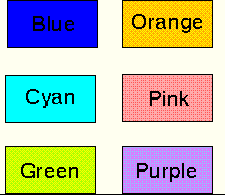 |
- cyan - secondary structure
- orange - tertiary: non-canonical
- green - tertiary: canonical (lone)
- pink - tertiary base triples (the underlying base pair is colored as a separate unit)
- purple - tertiary: pseudoknots
- blue - tertiary: parallel
|
Unpaired Nucleotides:
- Hairpin Loop (H) - nucleotides capping the end of a single helix.
- Internal Loop (I) - nucleotides flanked by two helices.
- Multi-Stem Loop (M) - nucleotides flanked by three or more helices.
Examples of Base Pair and Unpaired Structural Motifs:
This set of figures shows these motifs using the color and letter codes defined above. Unpaired nucleotides are designated in red with the single-letter codes H, I, or M.
Position numbers refer to the E. coli 16S and 23S rRNA structures. These structures are available for 16S and 23S (5' and 3') rRNA in PostScript format.
Selecting an image will download a PostScript version of that image.
| The 50-120 Region of 23S rRNA has several tertiary interactions: one lone canonical base pair (67:74), two pseudoknot helices (61-62/92-93 and 64-66/88-90), and a non-canonical base pair (53:117). |
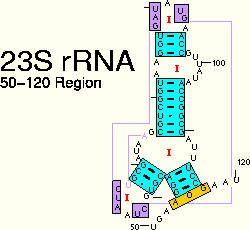 |
| Two tertiary interactions are present in the 290-350 Region of 23S rRNA: a lone canonical pair (319:323) and a pseudoknot helix (317-318/333-334). |
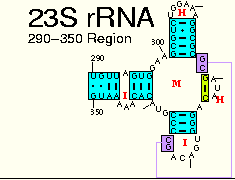 |
| The 1030-1124 Region of 23S rRNA has seveal tertiary interactions: two canonical lone base pairs (1082:1086 and 1087:1102), a base triple ((1092:1099)1072) and three non-canonical tertiary base pairs (1032:1122, 1039:1116, and 1040:1115). |
 |
| A lone canonical pair appears at 1359:1372 in the 1340-1605 region of 23S rRNA. Other tertiary interactions in this region are the non-canonical base pair 1348:1598 and the pseudoknot helix (1343-1344/1403-1404). |
 |
| A unique feature of this region (2102-2187) of 23S rRNA is the set of three parallel base pairs (shown in blue: 2112:2169, 2113:2170, and 2117:2172). Two non-canonical base pairs (2104:2185 and 2109:2180) and one unusual base triple (2111(2144:2147) also appear. |
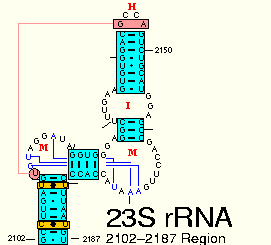 |
Nested Interactions and Pseudoknots:
Our definition of secondary structure base pairs includes the condition that those interactions must be nested. The topological arrangement of nested and pseudoknotted interactions are displayed in the following two figures. The standard view of the secondary structure of tRNA (PostScript) is available for comparison.
| This figure presents the structure of tRNA in a histogram format to reveal nested and pseudoknotted base interactions. Here the tRNA sequence progresses in the X direction, from 5' (at left) to 3' (at right). Base-base and base-basepair (triple) interactions are shown with vertical and horizontal lines connecting the nucleotide positions along the midline. Secondary structure base pairs are shown above this line (in blue), while tertiary interactions appear below the midline. Tertiary base pairs (non-canonical pairs, lone pairs, and pseudoknots) are colored red, while base triples are shown in green. |
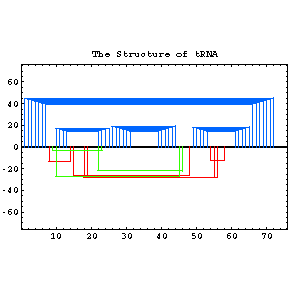 |
| A circular structure diagram provides another perspective on the tRNA structure. The tRNA sequence is shown as a circle, with the 5' end at the top of the circle and progressing clockwise to the 3' end. Secondary base pairs are connected with blue lines, tertiary base pairs (non-canonical pairs, lone pairs, and pseudoknots) are connected with red lines, and tertiary base triples are connected with green lines. |
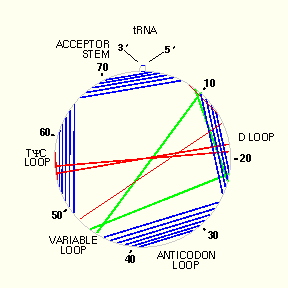 |








